

GRANT Service Broker Permissions (Transact-SQL) Permission Specifies a permission that can be granted on a Service Broker securable.
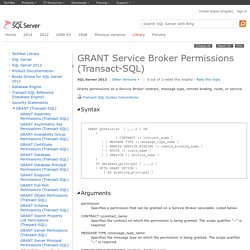
Listed below. CONTRACT ::contract_name Specifies the contract on which the permission is being granted. The scope qualifier "::" is required. MESSAGE TYPE ::message_type_name Specifies the message type on which the permission is being granted. REMOTE SERVICE BINDING ::remote_binding_name. Identity and Access Control (Service Broker) Most Service Broker applications that involve more than one instance run in the security context of a database principal created specifically for the application.
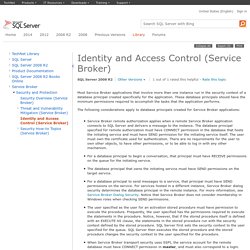
These database principals should have the minimum permissions required to accomplish the tasks that the application performs. GRANT Service Broker Permissions (Transact-SQL) Permission Specifies a permission that can be granted on a Service Broker securable.
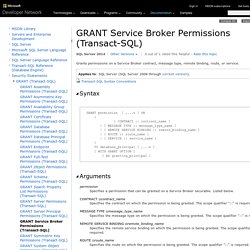
Listed below. CONTRACT ::contract_name. Centralized Asynchronous Auditing with Service Broker. By Mladen Prajdić on 16 July 2007 | 4 Comments | Tags: Administration, Service Broker Article Series Navigation: Service Broker is a new feature in SQL Server 2005.
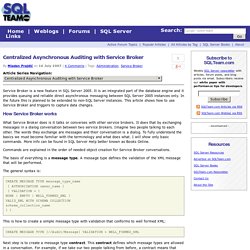
It is an integrated part of the database engine and it provides queuing and reliable direct asynchronous messaging between SQL Server 2005 instances only. In the future this is planned to be extended to non-SQL Server instances. This article shows how to use Service Broker and triggers to capture data changes. Centralized Asynchronous Auditing across Instances and Servers with Service Broker. By Mladen Prajdić on 20 August 2007 | 7 Comments | Tags: Administration, Service Broker Article Series Navigation: In my previous article I showed how to asynchronously audit data in one instance with one central database that holds audited data from all other databases on that instance.

So to continue showing the greatness that is Service Broker this article explains how to do the same with multiple servers or instances. This means that a single server holds audited data from all other servers. It's a classic many to one (one to many) scenario. New terminology we need to know I've covered the basic terminology in the previous article so if you're not familiar with it go read that first. Endpoints provide a means of communication between instances. How to troubleshoot Service Broker problems.
By Mladen Prajdić on 21 August 2007 | 0 Comments | Tags: Service Broker Article Series Navigation: In my first and second article about Service Broker I've shown how to build a central data repository on one server with one database that stores data (fist article) and across multiple servers with a single server that stores all data (second article).

In this one I'll discuss some of the problems that can arise and how to troubleshoot them. Tools at our disposal. Removing Poison Messages. A poison message is a message containing information that an application cannot successfully process.
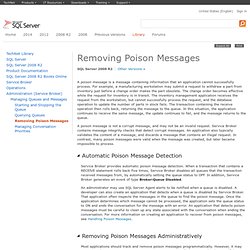
For example, a manufacturing workstation may submit a request to withdraw a part from inventory just before a change order makes the part obsolete. The change order becomes effective while the request for inventory is in transit. Database - Integration transport choice (Oracle + SQL Server) Download Microsoft® SQL Server® 2012 Feature Pack from Official Microsoft Download Center. Announcing Service Broker External Activator - SQL Server: Service Broker Team Blog. The Microsoft SQL Server Service Broker External Activator (EA) is distributed in the Microsoft SQL Server 2008 Feature Pack.
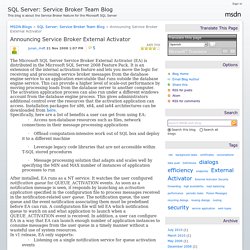
It is an extension of the internal activation feature and lets you move the logic for receiving and processing service broker messages from the database engine service to an application executable that runs outside the database engine service. This can provide a higher level of scale-out performance by moving processing loads from the database server to another computer.
The activation application process can also run under a different windows account from the database engine process. This gives administrators additional control over the resources that the activation application can access. Installation packages for x86, x64, and ia64 architectures can be downloaded from here. Specifically, here are a list of benefits a user can get from using EA: · Access non-database resources such as files, network connections in their message processing applications. Get Started With Using External Activator - SQL Server: Service Broker Team Blog. In the blog post Announcing Service Broker External Activator, we introduced Service Broker External Activator and showed what benefits a broker user can get from using it.
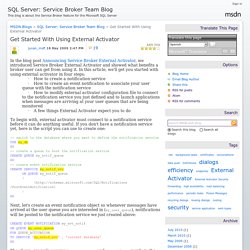
In this article, we'll get you started with using external activator in four steps: Get Started With Using External Activator - SQL Server: Service Broker Team Blog. Configuring Projects and Packages Using Parameters - SSIS Team Blog. Today’s post is from Rakesh Parida, an SDET on the SQL Server Integration Services team.

With SQL Server ‘Denali’, we introduce the new paradigm of parameters. Parameters are objects within the SSIS packages whose values can be predetermined or easily configured while executing the package. These parameters can be used to configure runtime behavior of package executions with the new server based storage model of SSIS packages; parameters are an efficient way to configure runtime values of package or project properties.
Types of Parameters With the new concept of Projects in SSIS, we can have parameters at package as well as project scopes. Package & Project Parameters in BIDS and SSMS. Getting Started with Parameters, Variables & Configurations in SSIS 2012 — SQL Chick. There’s actually not too much new here with *package* variables in SSIS 2012 (other than you can move them now which is great). What can get confusing is that sometimes the environment variables are just referred to as variables – so you need to be aware of the context in which variables are being discussed. (Environment variables are discussed in the next section below.) Within a package, SSIS variables have an expression property.
The expression property, and the ability to change values during the execution of a package if needed, are two fundamental differences variables have from parameters. Execute SSIS via Stored Procedure (SSIS 2012) The SSIS 2012 Catalog integration with SQL Server comes with the advantage of being able to execute SSIS packages indigenously from within T-SQL, along with a host of other functionality including improved monitoring and logging, integrated security and obviously the new deployment model. Executing SSIS packages by calling a stored procedure can be handy in many situations, but also comes with some (albeit minor) stipulations and quirks, this post tries to go through some of the basics of executing SSIS packages through stored procedures, while also touching lightly on some of the issues I encountered while having a go at this new SSIS execution method.
SSIS packages are executed asynchronously through a collection of procedures, these procedures perform functions such as initialize the execution context of a package, control the package/project/environment parameters, and kick off a particular execution context. DECLARE @exec_id BIGINT EXEC [SSISDB]. [catalog]. SELECT @exec_id EXEC [SSISDB]. Deploy and Execute SSIS Packages using Stored Procedures. When you configure an Integration Services project to use the project deployment model, you can use stored procedures in the SSIS catalog to deploy the project and execute the packages. For information about the project deployment model, see Deployment of Projects and Packages.
OPENROWSET (Transact-SQL) 'provider_name' Is a character string that represents the friendly name (or PROGID) of the OLE DB provider as specified in the registry. provider_name has no default value. 'datasource' Is a string constant that corresponds to a particular OLE DB data source. datasource is the DBPROP_INIT_DATASOURCE property to be passed to the IDBProperties interface of the provider to initialize the provider. Create the SSIS Catalog. After you design and test packages in SQL Server Data Tools, you can deploy the projects that contain the packages to an Integration Services server.
Before you can deploy the projects to the Integration Services server, the server must contain the SSISDB catalog. The installation program for SQL Server 2012 does not automatically create the catalog; you need to manually create the catalog by using the following instructions. You can create the SSISDB catalog in SQL Server Management Studio. You also create the catalog programmatically by using Windows PowerShell. To create the SSISDB catalog in SQL Server Management Studio Open SQL Server Management Studio. Calling a Web Service from a SQL Integration Services package. Introduction. Cannot show Visual Studio Tools for Application editor in SSIS 2012. Deploy and Execute SSIS Packages using Stored Procedures.
Service Broker Demystified - [DEFAULT] is not the DEFAULT. People tell me all the time that they don't want to use Service Broker because it is too confusing. I started a blog series called Service Broker Demystified to dispel these misconceptions. Today we are going to cover the [DEFAULT] objects, which are not really default objects...sometimes. Quick review...a contract binds a message type (defined as the name of a message and how it is validated) to who may send it during a dialog. Service Broker Demystified - Contracts and Message Types. People tell me all the time that they don't want to use Service Broker because it is too confusing. There are too many moving parts. Service Broker Demystified - Why do we need Services and Queues? People claim that they don't want to use Service Broker because it is too complicated. I started a blog series called Service Broker Demystified because SSB really isn't that difficult if you understand some basic concepts.
Today we are going to cover why we need both Services and Queues. Let's start with some definitions. A Service is used to route messages to the correct queue and enforce any contracts for a message. Service Broker Demystified - Services. This is another post in my Service Broker Demystified series. Services and [DEFAULT] contracts can be a bit confusing. Let's see if we can clear things up. I already covered the basics of Services and Contracts here and here. If you want to follow along with the examples for this post you can download the repro script here. A bit of trivia first...what is the difference between ServiceA and ServiceB in the screenshot below? Same queue? " Service Broker Demystified Series. Hypothetical questions: Sql server - SQL Service Broker Internal Activation Questions. Configuring Service Broker for Asynchronous Processing - SQLPerformance.com.
Cannot receive the message (exception in transmission_status) RECEIVE (Transact-SQL) The RECEIVE statement reads messages from a queue and returns a result set. The result set consists of zero or more rows, each of which contains one message. Allen White : Service Broker Basics. I'm currently implementing a Service Broker solution at a client site, and it's been an interesting challenge, because there's not a lot of information out there to help guide you through the process. Here I'd like to walk you through the basics. Message Types. Lesson 2: Beginning a Conversation and Transmitting Messages. Service Broker Tutorials. SSIS Tutorial: Creating a Simple ETL Package. Integration Services (SSIS) Connections.